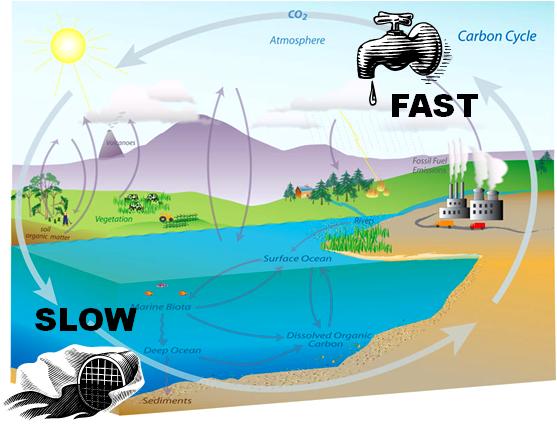Curbing the chemistry of climate change
The 2011 Harvard Radcliffe Institute Science Symposium, “Something in the Air: Climate Change, Science, and Policy” [1] brought together internationally renowned researchers to address the state of our current knowledge of climate science and courses of action that might lie ahead in addressing human-induced climate change. Chemistry plays an essential role in every aspect of studying and modeling the climate, as well as developing predictions and potential solutions to human-induced climate change. Not sure what chemistry’s got to do with it? Read on!
The root of the problem: Carbon chemistry, climate change and you
Natural climate fluctuations have been documented to occur on a geologic time scale (that is, over millions of years) throughout Earth’s history. Climate change can also occur at a faster pace (over a period of years), for example after major volcanic eruptions. However, current climate change trends are occurring at a rate and pattern that exceeds known natural phenomena. Instead, scientific evidence has led to a consensus that human activity is the predominant factor affecting current climate trends. The primary driving force behind human-induced global climate change is a rise in carbon dioxide levels in the Earth’s atmosphere produced by burning fossil fuels. To get a sense of the scale of human carbon emission, consider that the analogous natural process, seeps in volcanoes, release approximately 600–1,500 megatons of carbon dioxide annually, while human activity produces 28,000 megatons per year, a thirty-fold difference in carbon emission [1].
To understand how the increased carbon levels in the atmosphere translate into climate change, it is useful to think about the Earth as having an “energy budget,” where the energy entering the system in the form of light radiation from the sun must be kept in balance with energy leaving the system and returning to space (Figure 1) [2]. This energy balance is influenced and altered by many complex factors, including levels of atmospheric gases — such as carbon dioxide — which absorb, trap, and prevent energy from escaping Earth into space in the form of heat [3]. Increased carbon dioxide retains more heat energy, leading to the overall trend of global warming. The change in energy due to current increases in carbon dioxide levels is the equivalent of stringing 1.7 Christmas tree light bulbs on every square meter of the planet’s surface.
Figure 1. Energy entering the Earth system from the Sun can either be absorbed or reflected. Greenhouse gases, including carbon dioxide, are effective absorbers of energy which is then released as heat within the Earth’s atmosphere. Thus, as carbon dioxide levels increase, the amount of energy absorbed and retained as heat within the atmosphere increases, while the percent of energy returning to space decreases, creating a warming trend. (Image credit: NASA)
Where’s the silver bullet?
What percent reduction of carbon emissions would turn the tide? In fact, even if all carbon emissions were stopped completely and immediately, the atmospheric levels of carbon dioxide would not change significantly in a human lifetime. The reason for this paradox is the long atmospheric retention time of carbon dioxide. If you take a look at how carbon cycles through the Earth, you will notice that carbon exchange occurs in a variety of places [4]. Carbon from the atmosphere is taken in by plants, trapped in rocks and sediments, and absorbed into the surface layers of the ocean. Think of the Earth’s carbon exchange system as a bathtub [5] where the carbon entering the atmospheric tub in the form of carbon dioxide is currently greater than that naturally being removed, or drained, from the system (Figure 2). As long as this continues, the planet will continue to warm.
Figure 2. Earth’s carbon cycle as a bathtub. (Image modified from NOAA [8])
To tackle the problem of global climate change we will have to address: 1) the “bathtub problem” (controlling the flow of carbon to/from the atmosphere); 2) humanitarian and political issues related to regional differences in the effects of climate change and per capita contributions to human-induced climate change; 3) commitments to making necessary changes to our infrastructures; and 4) the temptation to “fix it later.”
Can geoengineering curb climate change?
Given that reducing or halting carbon dioxide emission immediately will have little impact on global warming, scientists are exploring other mitigation strategies in a rapidly growing, diverse field of research, termed geoengineering. Interestingly, much has been known about the environmental impact of fossil fuel burning and the potential for application of geoengineering for a very long time. For example, a 1965 report to President Johnson mentions solar radiation management (SRM), the concept of making the atmosphere more reflective and thus decreasing the amount of sunlight reaching and heating up Earth’s surface. SRM is one of multiple geoengineering strategies under investigation today and might be employed in the future as a short-term climate intervention in combination with other long-term emissions reduction and/or carbon removal policies.
SRM is analogous to the natural phenomenon that occurs when volcanic eruptions send small, reflective, sulfur-based particles into the atmosphere [6] (Figure 3), which scatter and reflect light, altering the energy budget of the planet for a few years. The Mt. Pinatubo eruption in 1991, the second largest in the 20th century, is one such example that produced a short-term, measurable global cooling of approximately 1.5°C [7]. SRM strategies based on this process would involve introduction of sulfur-based particulates into Earth’s upper atmosphere, known as the stratosphere.
Figure 3. Stratospheric layer of sulfur particles resulting from 1991 Mt. Pinatubo volcanic eruption. (Image credit: NASA Ames Research Center)
A critical parameter in SRM is the control of particle size, which must be maintained under 0.5 micrometers (1 micrometer is one millionth of a meter) to be effective in scattering light. In addition to size, sulfur is likely not the best option for the particle material due to the shear amount that would be needed for full-scale SRM and its potential impacts on the ozone layer. Sulfur in the stratosphere participates in series of chemical reactions with chlorine and other atmospheric gases that can damage Earth’s ozone layer, which, as we all know, is crucial to protecting life on Earth from the harmful effects of the sun’s radiation. Research into the potential effects of routine SRM application on global climate is ongoing. However, no large scale SRM experiments have been conducted to date, so predicted risks come from modeling based on our current understanding of climate science, chemistry, and aerosol physics. Another emerging field, nanotechnology, is likely to provide new alternatives to sulfur-based materials for SRM.
Is it worth the risk? You will have the chance to help decide!
SRM has huge ethical and policy implications that must be considered and discussed thoroughly among researchers, lawmakers and the public before it is applied in the future. The cost of SRM is relatively low compared to other climate change mitigation technologies or interventions. While this could be advantageous, it also creates significant risks in terms of global security because the low-cost, fast-acting nature of SRM, coupled with the way climate change affects regions of the globe differently, could lead to global conflict. The environmental hazards of SRM (including ozone depletion) cannot be fully evaluated or predicted without knowing which SRM technology to employ, but the appropriate technology cannot be identified without large-scale field tests that have inherent associated risks. Policies will have to be designed to address and balance these risks. Furthermore, besides lowering global temperature, SRM does not address many biogeochemical effects of carbon dioxide, including ocean acidification (which happens when CO2 is dissolved in water to make carbonic acid) [8]. At the end of the day, SRM technology is only an imperfect and temporary fix. It does not remove the need to reduce emissions, and should not delay decisions to address climate change.
Science can inform debate and provide a means of predicting and assessing potential risks and consequences, but it will not provide definitive answers to questions of if, how, when, and where geoengineering strategies should be implemented. Those answers will be left to all of us to determine as a global society, act accordingly, and assume responsibility for unintended consequences.
Silver buckshot not silver bullets
A multitude of mitigation strategies will likely have to be implemented in order to alter the course of human-induced climate change. In the words of the eminent atmospheric chemist, Dr. Susan Solomon, “While there are no silver bullets, there is lots of silver buckshot.” Climate science has described the trends and their relation to human activity; it is now up to all of us to think, discuss, and take action, with a view beyond our generation and our own backyard.
Get started, get informed, and do something!
There are a number of things that individuals can do to make personal choices to alter their carbon footprint and influence climate policy. Here are a few resources to get you going:
Get started:
“Global Warming: Now What?” Harvard Science in the News 2007 Lecture Series. https://sitn.hms.harvard.edu/seminar_archives/2007/sitn20070101.pdf
Climate Central: http://www.climatecentral.org/
Global Carbon Project: http://www.globalcarbonproject.org/index.htm
Aerosols: Tiny particles, Big Impact: http://earthobservatory.nasa.gov/Features/Aerosols/page1.php
Atmospheric System Research – U.S. Dept. of Energy: http://asr.science.energy.gov/science/
Solar Radiation Management: http://science.house.gov/sites/republicans.science.house.gov/files/documents/hearings/020410_Keith.pdf
Solar Radiation Management Governance Initiative: http://event.arc.nasa.gov/main/home/reports/SolarRadiationCP.pdf
Take action:
EPA Household Emissions Calculator: http://www.epa.gov/climatechange/emissions/ind_calculator.html
What You Can Do: http://www.epa.gov/climatechange/wycd/index.html
Encyclopedia of Earth – Climate Change Solutions: http://www.eoearth.org/topics/view/54141/
America’s Climate Choices – A Report of the National Research Council: http://americasclimatechoices.org/
For children (and all lovers of Dr. Seuss): http://www.energystar.gov/index.cfm?c=kids.lorax
For educators: http://www.scienceeducation.gov/search/apachesolr_search/climate%20change
Morgan Thompson is a PhD student in Biological and Biomedical Sciences at Harvard Medical School.
References
[1] “Something in the Air: Climate Change, Science, and Policy.” 2011 Harvard Radcliffe Institute Science Symposium. http://www.radcliffe.edu/events/calendar_2011climate.aspx
[2] “Global Energy Balance.” Earth Guide. University of California San Diego. http://earthguide.ucsd.edu/earthguide/diagrams/energybalance/
[3] “Climate Forcings and Global Warming.” Earth Observatory. National Aeronautics and Space Administration. http://earthobservatory.nasa.gov/Features/EnergyBalance/page7.php
[4] “Carbon Cycle Toolkit.” Teacher Resources. National Oceanic and Atmospheric Administration. http://www.esrl.noaa.gov/gmd/outreach/carbon_toolkit/basics.html
[5] “The Carbon Bathtub.” National Geographic, Dec 2009. http://ngm.nationalgeographic.com/big-idea/05/carbon-bath
[6] “Volcanic Sulfur Aerosols Affect Climate and the Earth’s Ozone Layer.” U.S. Geological Survey. http://volcanoes.usgs.gov/hazards/gas/s02aerosols.php
[7] “Teachers Guide to Stratovolcanoes of the World.” National Oceanic and Atmospheric Administration. http://www.ngdc.noaa.gov/hazard/stratoguide/pinfeat.html
[8] “Ocean Acidification.” National Oceanic and Atmospheric Administration. http://www.pmel.noaa.gov/co2/story/Ocean+Acidification





